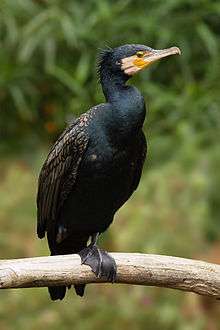Phalacrocorax
Phalacrocorax is a genus of fish-eating birds in the cormorant family Phalacrocoracidae.
| Phalacrocorax | |
|---|---|
 | |
| Great cormorant (Phalacrocorax carbo) | |
| Scientific classification | |
| Kingdom: | Animalia |
| Phylum: | Chordata |
| Class: | Aves |
| Order: | Suliformes |
| Family: | Phalacrocoracidae |
| Genus: | Phalacrocorax Brisson, 1760 |
| Type species | |
| Pelecanus carbo | |
| Species | |
|
See text | |
Taxonomy
The genus Phalacrocorax was introduced by the French zoologist Mathurin Jacques Brisson in 1760 with the great cormorant (Phalacrocorax carbo) as the type species.[1][2] Phalacrocorax is the Latin word for a "cormorant".[3]
The genus contains 22 species including one species that became extinct in the 19th century.[4]
- Red-legged cormorant or red-footed shag, Phalacrocorax gaimardi
- Flightless cormorant, Phalacrocorax harrisi
- Bank cormorant or Wahlberg's cormorant, Phalacrocorax neglectus
- Spotted shag Phalacrocorax punctatus
- Pitt shag or Featherstone's shag Phalacrocorax featherstoni
- †Pallas's cormorant or spectacled cormorant, Phalacrocorax perspicillatus
- Brandt's cormorant, Phalacrocorax penicillatus
- Pelagic cormorant or Baird's cormorant, Phalacrocorax pelagicus
- Red-faced cormorant, Phalacrocorax urile
- Neotropic cormorant or olivaceous cormorant, Phalacrocorax brasilianus (or Phalacrocorax olivaceus)
- Double-crested cormorant or white-crested cormorant, Phalacrocorax auritus
- European shag or common shag, Phalacrocorax aristotelis
- Black-faced cormorant, Phalacrocorax fuscescens
- Indian cormorant, Phalacrocorax fuscicollis
- Little black cormorant, Phalacrocorax sulcirostris
- Australian pied cormorant or yellow-faced cormorant, Phalacrocorax varius
- Great cormorant or black shag, Phalacrocorax carbo
- White-breasted cormorant, Phalacrocorax lucidus
- Japanese cormorant or Temminck's cormorant, Phalacrocorax capillatus
- Cape cormorant, Phalacrocorax capensis
- Socotra cormorant, Phalacrocorax nigrogularis
- Rock shag, Phalacrocorax magellanicus
A molecular phylogenetic study published in 2014 found that the genus Phalacrocorax was non-monophyletic and that a group of five species currently placed in this genus were more closely related to members of Leucocarbo. This group contained the rock shag, the double-crested cormorant, the neotropic cormorant, the flightless cormorant and the European shag.[5]
References
- Brisson, Mathurin Jacques (1760). Ornithologie, ou, Méthode Contenant la Division des Oiseaux en Ordres, Sections, Genres, Especes & leurs Variétés (in French and Latin). Paris: Jean-Baptiste Bauche. Vol. 1, p. 60, Vol. 6, p. 511.
- Mayr, Ernst; Cottrell, G. William, eds. (1979). Check-list of Birds of the World. Volume 1 (2nd ed.). Cambridge, Massachusetts: Museum of Comparative Zoology. p. 163.
- Jobling, J.A. (2019). del Hoyo, J.; Elliott, A.; Sargatal, J.; Christie, D.A.; de Juana, E. (eds.). "Key to Scientific Names in Ornithology". Handbook of the Birds of the World Alive. Lynx Edicions. Retrieved 9 April 2019.
- Gill, Frank; Donsker, David, eds. (2019). "Hamerkop, Shoebill, pelicans, boobies, cormorants". World Bird List Version 9.1. International Ornithologists' Union. Retrieved 12 April 2019.
- Kennedy, M.; Spencer, H.G. (2014). "Classification of the cormorants of the world". Molecular Phylogenetics and Evolution. 79: 249–257. doi:10.1016/j.ympev.2014.06.020. PMID 24994028.